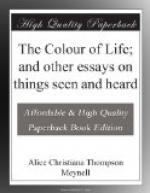But the privation of cloud is indeed a graver loss than the world knows. Terrestrial scenery is much, but it is not all. Men go in search of it; but the celestial scenery journeys to them. It goes its way round the world. It has no nation, it costs no weariness, it knows no bonds. The terrestrial scenery—the tourist’s—is a prisoner compared with this. The tourist’s scenery moves indeed, but only like Wordsworth’s maiden, with earth’s diurnal course; it is made as fast as its own graves. And for its changes it depends upon the mobility of the skies. The mere green flushing of its own sap makes only the least of its varieties; for the greater it must wait upon the visits of the light. Spring and autumn are inconsiderable events in a landscape compared with the shadows of a cloud.
The cloud controls the light, and the mountains on earth appear or fade according to its passage; they wear so simply, from head to foot, the luminous grey or the emphatic purple, as the cloud permits, that their own local colour and their own local season are lost and cease, effaced before the all-important mood of the cloud.
The sea has no mood except that of the sky and of its winds. It is the cloud that, holding the sun’s rays in a sheaf as a giant holds a handful of spears, strikes the horizon, touches the extreme edge with a delicate revelation of light, or suddenly puts it out and makes the foreground shine.
Every one knows the manifest work of the cloud when it descends and partakes in the landscape obviously, lies half-way across the mountain slope, stoops to rain heavily upon the lake, and blots out part of the view by the rough method of standing in front of it. But its greatest things are done from its own place, aloft. Thence does it distribute the sun.
Thence does it lock away between the hills and valleys more mysteries than a poet conceals, but, like him, not by interception. Thence it writes out and cancels all the tracery of Monte Rosa, or lets the pencils of the sun renew them. Thence, hiding nothing, and yet making dark, it sheds deep colour upon the forest land of Sussex, so that, seen from the hills, all the country is divided between grave blue and graver sunlight.
And all this is but its influence, its secondary work upon the world. Its own beauty is unaltered when it has no earthly beauty to improve. It is always great: above the street, above the suburbs, above the gas-works and the stucco, above the faces of painted white houses—the painted surfaces that have been devised as the only things able to vulgarise light, as they catch it and reflect it grotesquely from their importunate gloss. This is to be well seen on a sunny evening in Regent Street.




